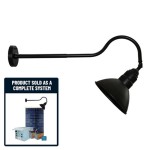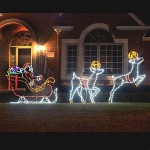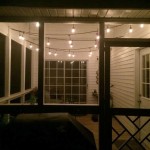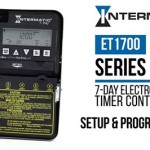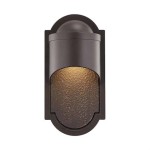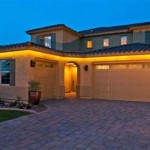Sensor Flood Lights Outdoor: Enhancing Security and Efficiency
Outdoor flood lights play a crucial role in enhancing security and illuminating outdoor areas. However, traditional flood lights remain illuminated constantly, leading to unnecessary energy consumption and potential light pollution. Sensor flood lights offer a more efficient and environmentally friendly alternative, activating only when motion is detected. This article delves into the benefits, features, and considerations of sensor flood lights for outdoor applications.
Benefits of Sensor Flood Lights
Sensor flood lights provide a host of advantages compared to conventional outdoor lighting solutions. Their primary benefit is energy efficiency. By illuminating only when motion is detected, these lights significantly reduce energy consumption, leading to lower electricity bills and a smaller carbon footprint. This energy saving is particularly impactful in areas with frequent nighttime activity, such as driveways, pathways, and backyards.
Beyond energy efficiency, sensor flood lights enhance security. The sudden illumination triggered by movement can deter potential intruders and provide crucial visibility in case of suspicious activity. The deterrent effect can create a sense of security and discourage criminal activity. Furthermore, the instant illumination allows for clear identification of individuals or objects in the vicinity, aiding in crime prevention and investigation.
Sensor flood lights also contribute to convenience. By automatically illuminating when needed, they eliminate the need for manual switching and provide instant light for nighttime activities, such as entering a home or navigating a dark area. This convenience is particularly valuable for seniors, individuals with mobility challenges, and anyone who appreciates a hands-free lighting solution.
Types of Motion Sensors
Sensor flood lights utilize various types of motion sensors to detect movement, each with its own characteristics and advantages. Passive infrared (PIR) sensors are the most common type, detecting changes in infrared radiation emitted by warm objects, such as humans or animals. These sensors are typically cost-effective and reliable, but they can be susceptible to false triggers from environmental factors like wind or rain.
Microwave sensors, on the other hand, emit radio waves that bounce off moving objects. They are less susceptible to environmental factors but tend to have a wider detection range than PIR sensors. Ultrasonic sensors emit sound waves and detect changes in the reflected waves, offering a broader detection angle and ability to operate in challenging conditions like fog or smoke.
Some sensor flood lights utilize a combination of sensor technologies, like PIR and microwave, for enhanced detection and reduced false triggers. The choice of sensor type depends on the specific application and environmental conditions.
Features and Considerations
When selecting sensor flood lights, several features and considerations come into play. The desired light output, measured in lumens, determines the brightness of the light. The color temperature, expressed in Kelvin (K), influences the appearance of the light, with warmer temperatures (around 2700K) providing a more yellowish hue and cooler temperatures (around 4000K) producing a whiter light.
The sensor's detection range and angle are crucial factors. The range determines the distance at which motion is detected, while the angle defines the area of coverage. The activation time, or the delay between motion detection and light illumination, can be adjusted to prevent unnecessary light bursts from fleeting movement. The light's duration, or the amount of time it remains illuminated after motion is detected, can also be customized.
Other features to consider include dimming capabilities, multiple light settings, and weather resistance. Dimming allows for adjustable light levels, while multiple settings can customize the light output for different scenarios. Weather resistance ensures the lights can withstand rain, snow, and other harsh weather conditions.
Sensor flood lights can be installed in a variety of ways, including mounting on walls, eaves, or poles. The chosen mounting method and installation location should align with the desired coverage area and environmental factors. Proper installation is crucial for optimal performance and longevity.

Jual Lampu Sorot Led 20 Watt Ip66 Flood Light Outdoor Cahaya Putih Warm White Jakarta Utara Crown Tokopedia

The Best Outdoor Motion Sensor Lights In 2024 Popular Science

Jual Solar Lights Outdoor Led Motion Sensor Wall 3 Lighting Modes Waterproof Powered For Garden Patio Yard Street Light Di Er Baosity Shehen China Blibli

Hunter Twin Led Flood Light Cct With Sensor 22w In White Or Black The Lighting

Best Onforu 100w Outdoor Led Security Flood Light Bd62 For

Solar Lights Outdoor 210led 2500lm Motion Sensor Security With Wireless Remote Control Waterproof 3 Heads Led Flood Wall For Porch Garage Yard Entryways Patio 1pack Com

Jual Lampu Sorot Led Flood Light Outdoor 50w Anti Air Hujan Kota Bandung Kemilau Tokopedia

How Led Flood Lights Can Improve Your Home S Security And Safety Simple Lighting Blog

50w Led Security Light Outdoor Flood Lights Daylight White Lepro

Awsens 3 Light White Outdoor Integrated Led Security Flood Wall Or Eave Mount Aw5083 Wh The Home Depot
Related Posts
